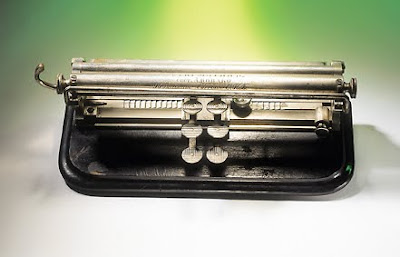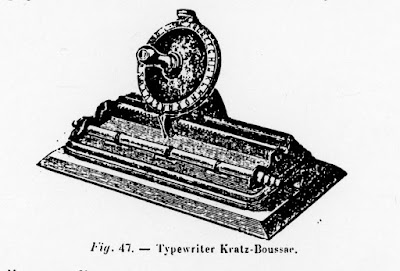Jolux is the name for a line of French children's typewriters. Here we have the Super Major (odd name for a three-bank machine) and the Electric 600, which uses a unique system in which a plastic typewheel is constantly spinning until you interrupt it and make it type. You can see how this bizarre machine works on Georg Sommeregger's blog. Are there any other electric toy typewriters?


OK, this one is not so obscure to typewriter historians, but it doesn't get as much credit as it deserves, in my opinion. If you see one of these, get it: it is a Jones Typographer, serially produced in an ill-fated factory in 1852.

Many typewriters have been called Junior. This one is a Danish index device.

Here's another Junior which is obviously based on the German Gundka, but marked "Made in England." Is it the same as the "Enoch Jones" typewriter I showed you last time?



Here is a K-Mek, a Korean portable reminiscent of a Brother.




Unless you have a vivid memory of ETCetera No. 73, you are probably unfamiliar with the Kabouter (Imp), a Dutch name variant of the Faktotum.

This Kleinschmidt Perforator No. 4 is not a typewriter, but it's interesting, right? It was used for creating punched tape for teletype transmissions.



This is a Kovako machine for the blind, made in Russia. (I'm not sure whether it creates Braille or uses another system.) Again, not strictly a "typewriter."

The Kratz-Boussac is a simple index machine more commonly known as the Eureka.

The only known Kruse is in Flavio Mantelli's collection, along with other one-of-a-kind typewriters.

The Leningrad is one of several similar typewriters made in the USSR with massive wide carriages.

This Lignose is one of several forgotten three-bank machines manufactured in the Weimar Republic. I really like its shape and its side-mounted ribbon spools.

This Lisa 30, made by Antares I believe, is in the running for Ugliest Typewriter.

This picture is in my files as "Ljubljana mystery machine." Made in Slovenia?



OK, this one is not so obscure to typewriter historians, but it doesn't get as much credit as it deserves, in my opinion. If you see one of these, get it: it is a Jones Typographer, serially produced in an ill-fated factory in 1852.

Many typewriters have been called Junior. This one is a Danish index device.

Here's another Junior which is obviously based on the German Gundka, but marked "Made in England." Is it the same as the "Enoch Jones" typewriter I showed you last time?



Here is a K-Mek, a Korean portable reminiscent of a Brother.
Unless you have a vivid memory of ETCetera No. 73, you are probably unfamiliar with the Kabouter (Imp), a Dutch name variant of the Faktotum.

This Kleinschmidt Perforator No. 4 is not a typewriter, but it's interesting, right? It was used for creating punched tape for teletype transmissions.



This is a Kovako machine for the blind, made in Russia. (I'm not sure whether it creates Braille or uses another system.) Again, not strictly a "typewriter."

The Kratz-Boussac is a simple index machine more commonly known as the Eureka.

The only known Kruse is in Flavio Mantelli's collection, along with other one-of-a-kind typewriters.

The Leningrad is one of several similar typewriters made in the USSR with massive wide carriages.

This Lignose is one of several forgotten three-bank machines manufactured in the Weimar Republic. I really like its shape and its side-mounted ribbon spools.
This Lisa 30, made by Antares I believe, is in the running for Ugliest Typewriter.
This picture is in my files as "Ljubljana mystery machine." Made in Slovenia?



Quite an education, this series. Love the Kleinschmidt Perforator No. 4, but I'm afraid poor Lisa is just too ugly! I hope it wasn't named after the designer's wife or daughter, as I'm sure they would be none too pleased.
ReplyDeleteHmmn, I have heard that all of Seiko's tooling went to Korea, so I suspect that K-Mek is a Seiko 700 series, like the little 70's Royals, rather than a Brother.
ReplyDeleteAlso, Lisa seems like an unlucky name to put on a machine, as Apple can attest. (:
A propósito de la "Lisa 30". En México aún se pueden encontrar máquinas "Pintaform": con molduras de plástico y un color marfil opaco y triste.
ReplyDeletePintaform era una empresa especializada en artículos de papelería, y sacó la máquina Pintaform como un artículo barato entre su línea de útiles escolares.
Seguro que también concursa por la Máquina de Escribir más fea.
¿La conoces?
No la conozco. ¡Estoy curioso!
DeleteI must say I have a soft spot for the Lisa 30. Depending on colour and angle of photography, it is a very cool design. We must follow up on the reputedly Slovenian machine.
ReplyDeleteThe Slovenian machine is a TOPS.
Delete